Digital diplomacy is no longer a novel phenomenon. In one form or another, digital diplomacy has existed for more than a decade. And yet scholars and practitioners continue to explore the practice and definition of digital diplomacy. During this process, different scholars and MFAs have offered different terms to understand the utilization of digital tools in diplomacy. The Finnish MFA uses the term “diplomacy in the digital age” rather than “digital diplomacy”. The difference between the terms is not just semantic. The term “diplomacy in the digital age” implies that the conduct of diplomacy has remained the same yet diplomacy is now practiced in a new digital environment. Conversely, the term digital diplomacy may suggest that this is a new form of diplomacy all together.
To date, scholars have suggested the terms net diplomacy, cyber diplomacy, digital diplomacy, diplomacy 2.0, networked diplomacy, real-time diplomacy and 21st century statecraft (See Hocking & Melissen’s 2015 report for their taxonomy). Each term has since been accompanied by both academic work and the adoption of new policies and procedures by MFAs and diplomats.
However, all these terms fail to grasp two fundamental features of the digitalization of diplomacy. The first is that digitalization is a process rather than a binary state of 1 (digital) and 0 (non-digital). MFAs around the world cannot be separated into digital and non-digital ministries. Rather, each MFA is in the midst of its own process of digitalization. Secondly, digitalization is a process that challenges the working routines, procedures, norms and metaphors of MFAs and diplomats.
The term “the digitization of diplomacy”, I believe, begins to capture the temporal and normative influence digitalization is having on diplomacy. Imbued within this term is the view of digitalization as a long term process whose influences far transcends the use of new tools or methods in diplomacy.
Notably, I use the term “the digitization of diplomacy” in reference to the impact digitalization has had on four dimensions of diplomacy: the institutions of diplomacy, the practitioners of diplomacy, the audiences of diplomacy and the conduct of diplomacy. Indeed digitalization affects each of these dimensions in a different manner. Moreover, I argue that digitalization by nature impacts the norms (values/beliefs), behaviours, working procedures and concepts /metaphors of individuals and organizations. What emerges is a 4*4 matrix shown below.
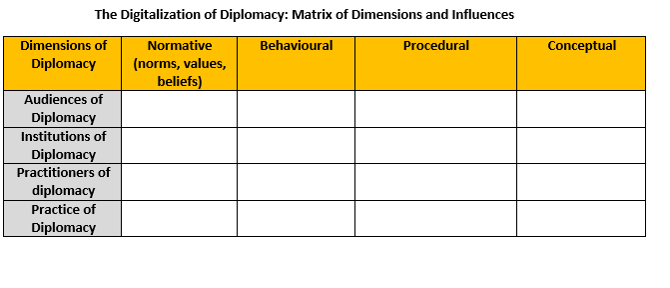
Consider, for instance, the impact digitalization has had on private individuals. As others have argued, the digital society is a sharing society, one that celebrates transparency, exposure and the publishing of private information. Only last year a university Professor became an online icon for publishing a CV of his failures listing all the grants and positions he failed to secure. This example suggests that digitalization has impacted the norms and values of individuals, their behaviours and their conceptualization of society. These are listed in the table below.

However, individuals not only share their failures. They also share their opinions, beliefs, political affiliations and perceptions of local and global events. Digitalization has thus given rise to an opinionated public that is clamouring to be heard (Craig Hayden, 2012). Notably, it is interesting to begin the analysis of digitalization’s impact on diplomacy from its audiences given that diplomacy is a social institution inhabited by social beings, diplomats. Moreover, before diplomacy can be practiced it must first be imagined by diplomats whose imagination is shaped by societal occurrences, technological metaphors and experiences. Indeed, once an Ambassador has used WhatsApp to communicate with his family he may soon use it to communicate with his peers.
When examining the institutions of diplomacy, digitalization has facilitated the adoption of new norms and beliefs such as valuing dialogue given online publics’ willingness to interact with diplomats. This norm has led to new behaviours (listening to feedback of online publics), new procedures and working routines (incorporating follower feedback into policy formulation) and a conceptual shift- the use of the network metaphor to imagine diplomacy.
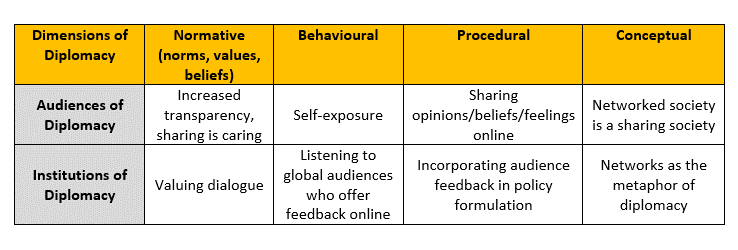
Next, if one evaluates the practitioners of diplomacy, he sees that digitalization has again led to new norms, behaviours, procedures and metaphors. Digitalization has caused, or forced, diplomats to embrace a new kind of openness given the increased agency of non-traditional actors (online publics, civil society groups, NGOs). The behaviour of diplomats has also changed as these seek to form temporary alliances, or networks, to advance a specific goal (e.g., network of NGOs, UN missions and online publics to advance a human rights resolution). From a procedural perspective, digitalization leads diplomats to engage, converse and meet with all these new actors. Finally, as Heine has argued, diplomats have abandoned the metaphor of the exclusive Club for that of the inclusive Network.
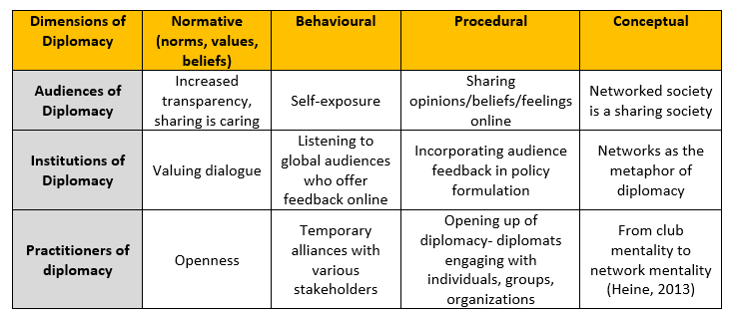
Finally, after taking into account the audiences, institutions and practitioners of diplomacy, one can investigate digitalization’s impact on the practice of diplomacy which is now collaborative in nature as it requires the formation of goal-originated networks in which multiple stakeholders come together to achieve foreign policy goals.
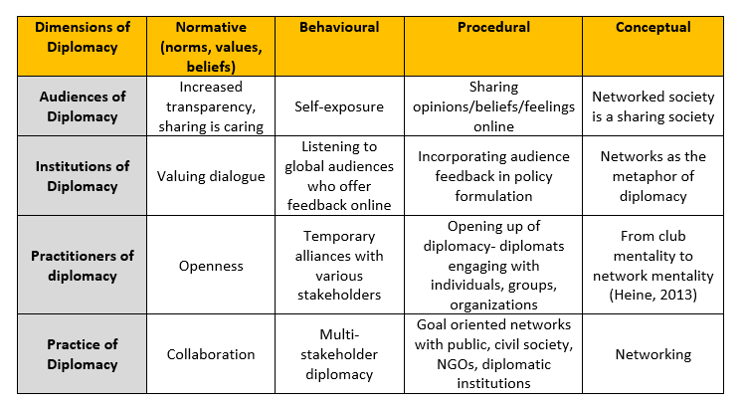
The term “the Digitalization of diplomacy”, as employed thus far, suggests that scholars and practitioners can focus on any dimension of diplomacy (audiences, institutions) and on any realm of influence (metaphors or norms). While some scholars may focus on the new working procedures digitalization has brought about in MFAs, others can focus on the various metaphors Ambassadors employ when practicing diplomacy.
As such, this matrix can bring order to the somewhat chaotic study of digital diplomacy.
Notably, one can also use this this matrix to chart how the four dimensions of diplomacy influence one another. For instance, individuals have embraced the value of connectivity and the view of the online environment as an extension of offline environments. As such, individuals of all ages now go online to gather information on local and global events. This has impacted the institutions of diplomacy who use online platforms to deliver consular aid, as was the case last week following the London terror attacks. The use on online platforms to deliver consular aid has caused a change in the beliefs and norms of MFAs who now view themselves as service providers. It has also seen the emergence of a new concept- that of domestic diplomacy. The practice of domestic diplomacy has, in turn, empowered embassies who are actually tasked with delivering aid following a terror attack or natural disaster. And so the practice of diplomacy has also changed as diplomacy must react immediately to events giving rise to what Philip Seib has dubbed Real-Time Diplomacy.
This process is depicted in the image below.
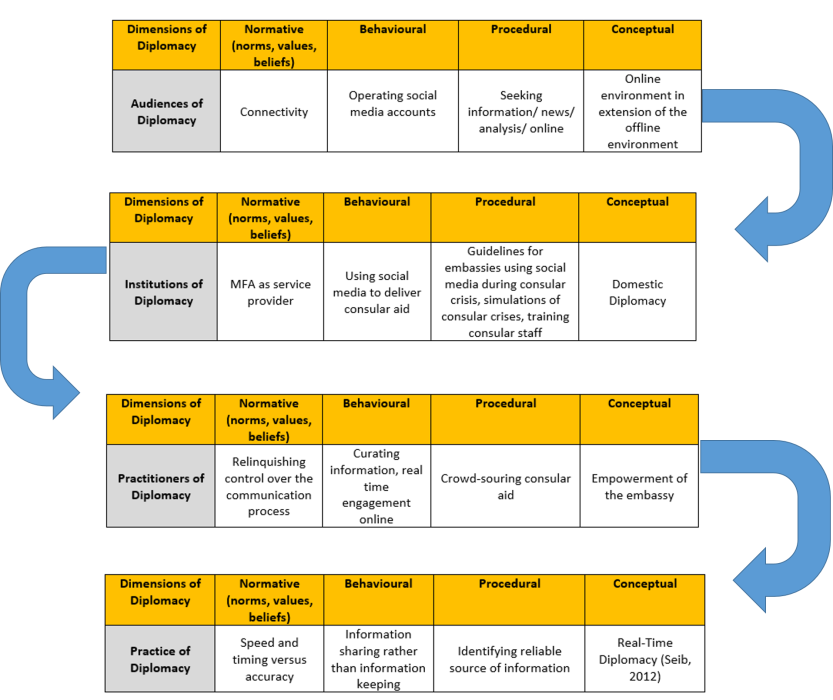
Finally, the matrix of “the Digitalization of Diplomacy” enables one to begin and map the various conceptions of digital diplomacy as offered by its many scholars and practitioners. This partial mapping is shown below.
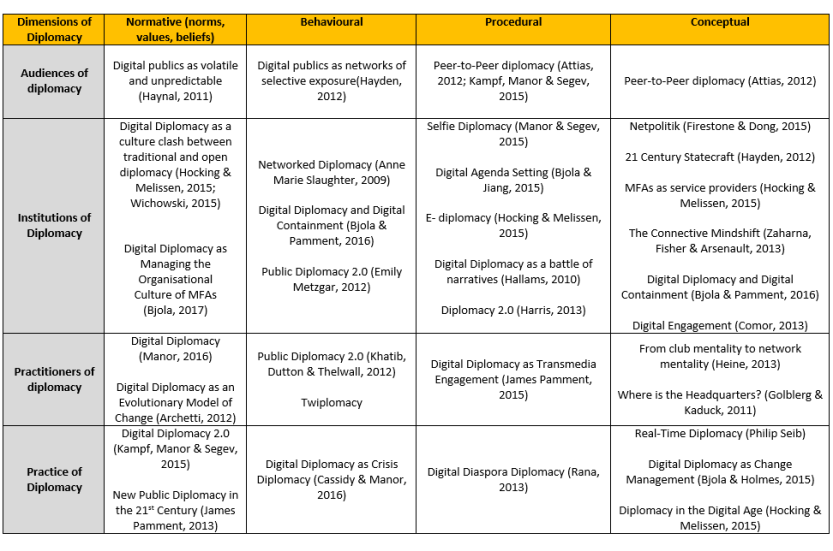
Conclusion
In this post I have endeavoured to offer a new, inclusive, term for the relationship between digitalization and diplomacy. While digital diplomacy has been a catch all phrase for this relationship, it fails to regard digitalization as a process and to identify digitalization’s realms of influence. The term “the digitalization of diplomacy” is thus not only more apt, but it may also enables scholars to better identify relevant areas of research and to map the scholarly work undertaken so far. For instance, rather that referring to the use of Twitter as “digital diplomacy”, one could identify this as a change in the behaviour and values of MFAs brought about by digitalization. Moreover, “the digitalization of diplomacy” more directly ties digital diplomacy with the digital society and digitalization in general as a process that alters societal metaphors, norms and behaviours. Lastly, “the digitalization of diplomacy” enables one to research how changes in digital publics lead to changes in MFAs, and vice versa.

2 thoughts on “The Digitalization of Diplomacy”